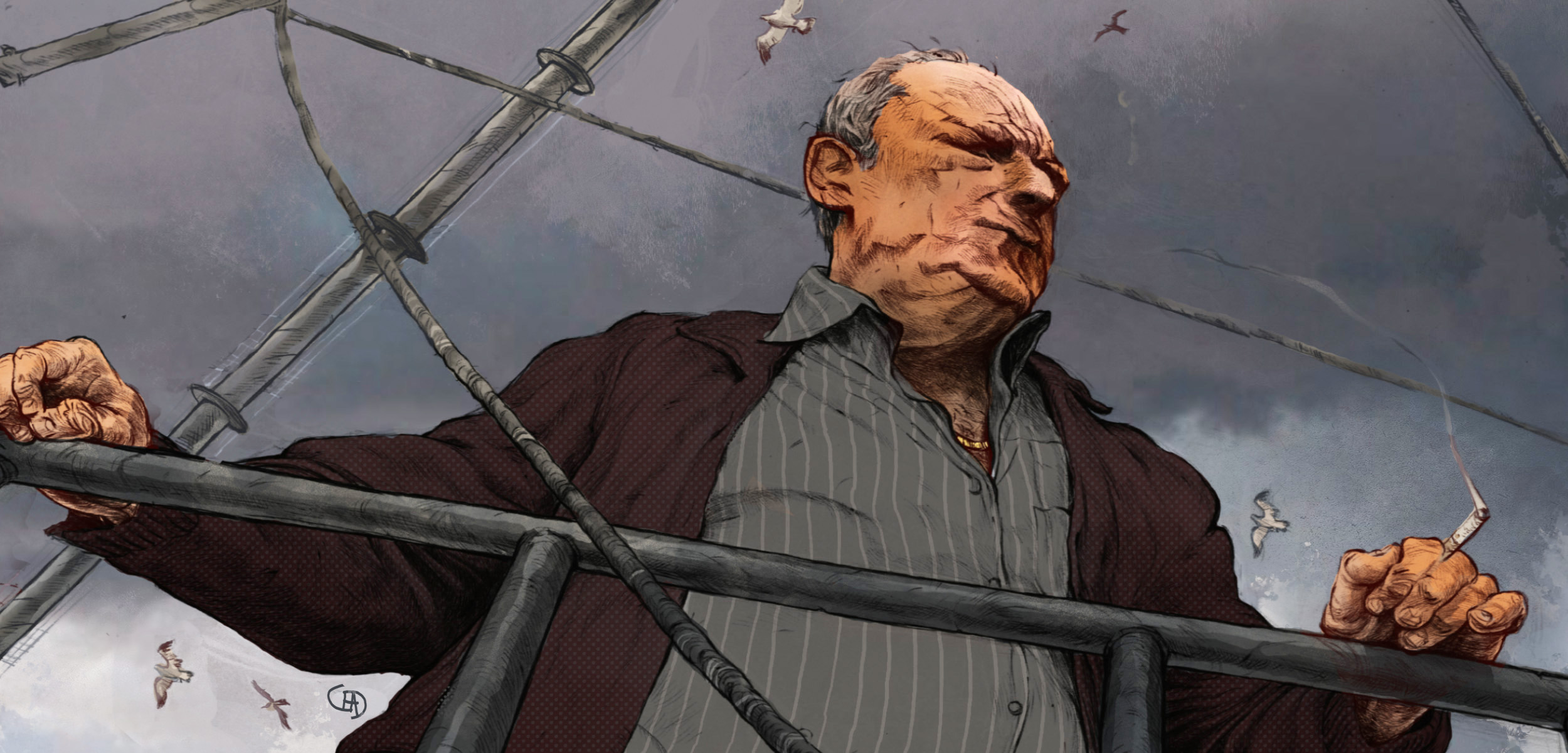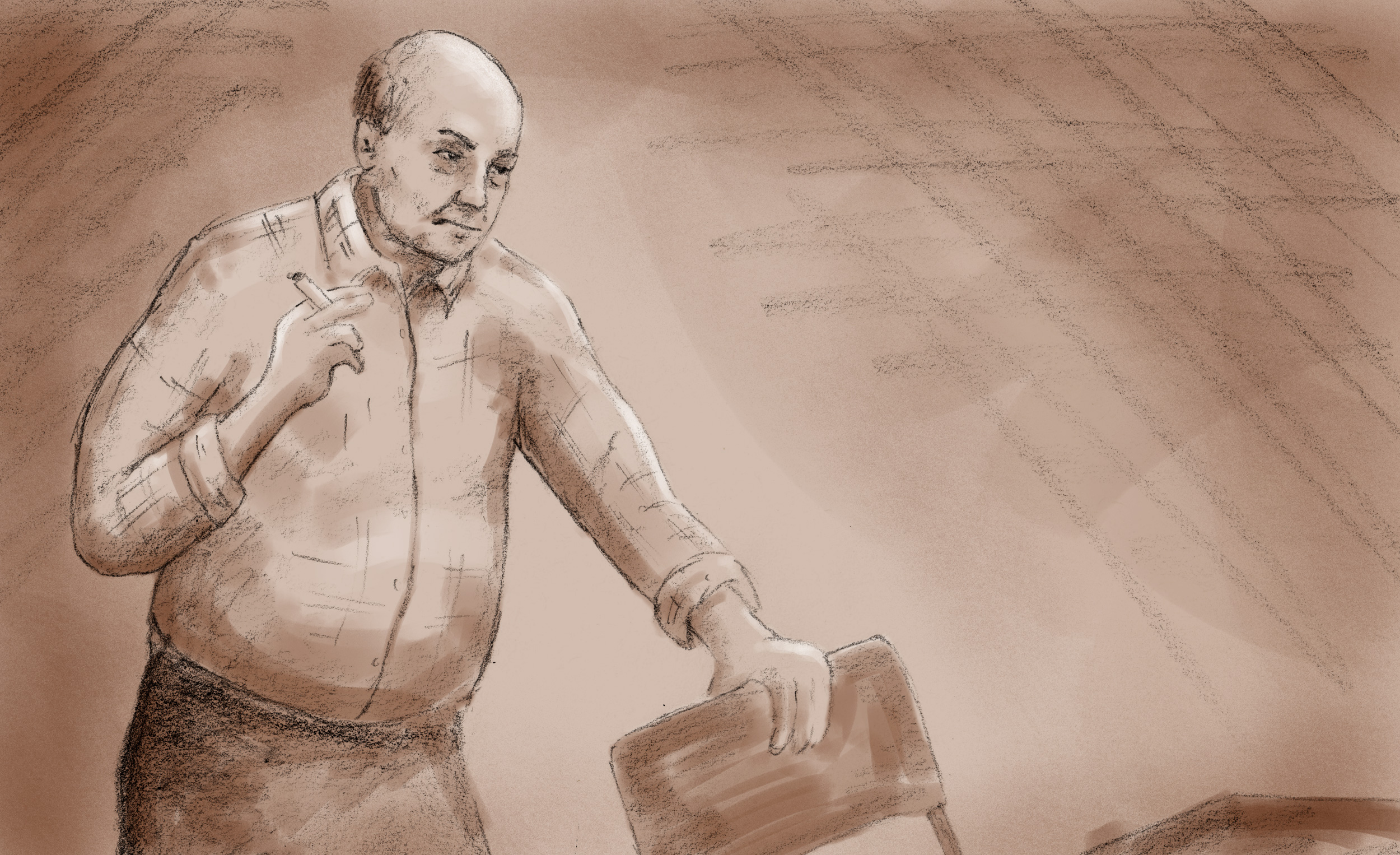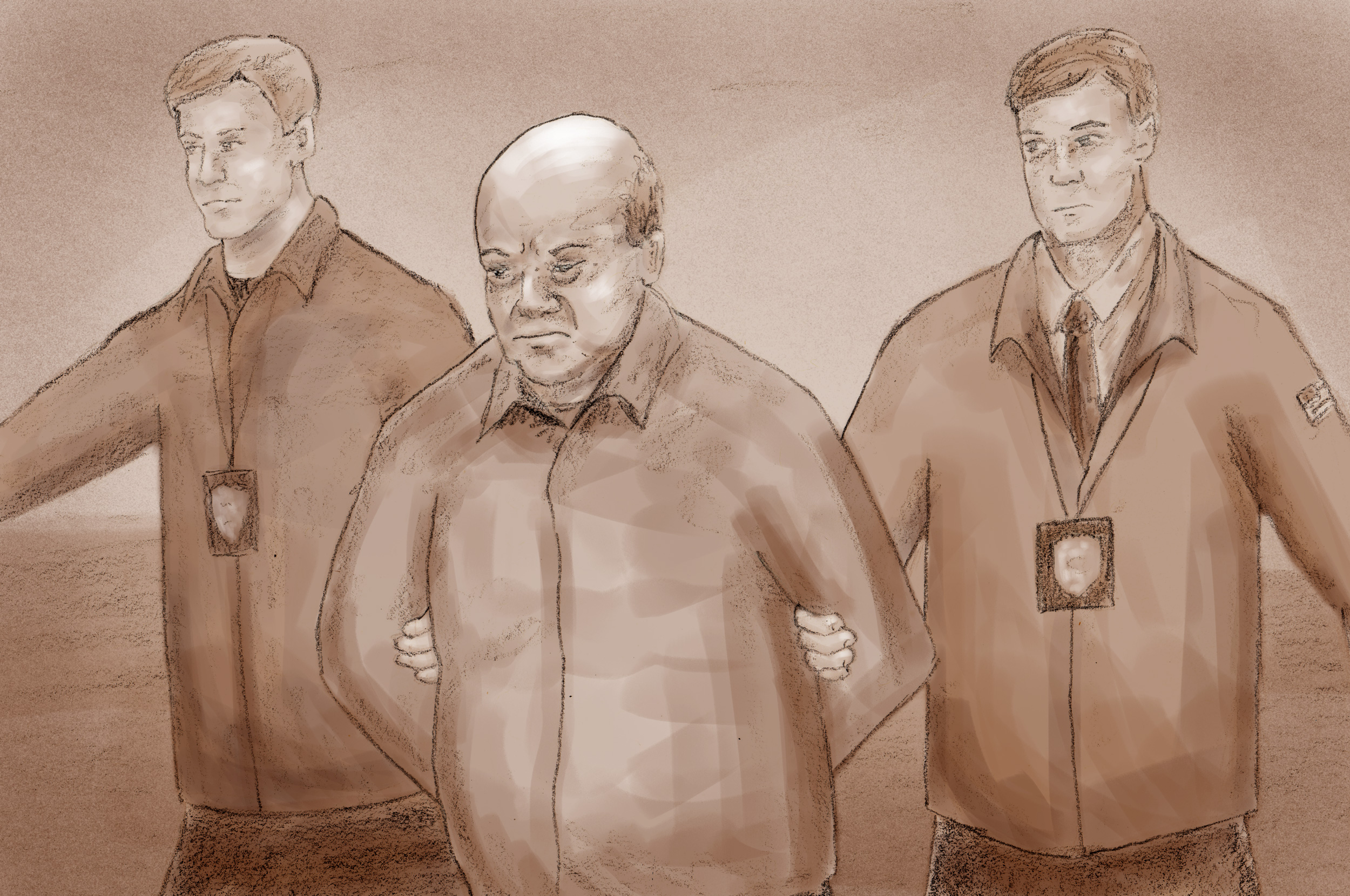The Last Trial of the Codfather
Since his release from prison in the 1980s, Carlos Rafael has ruthlessly run his Massachusetts seafood business with little regard for the law. But is there any other way to survive the gauntlet of restrictions on the New England fishing industry?
Article body copy
It’s another quiet July day at the fish auction in New Bedford, Massachusetts. When I arrive at dawn before the bidding begins, three men are seated at folding tables, waiting for a darkened television screen to flicker on. The drone and dribble of a Keurig coffee machine is the only sound interrupting the silence. It promises to be another wistful day in a long series of wistful days.
Last night, just nine fishing boats pulled up to the dock behind the building, far fewer than the hundreds of boats lining up for the old city auction on Pier 3 in the 1980s. Back then, boats would haul in as much as 500 tonnes of cod, haddock, flounder, and other species of groundfish from the icy depths of the North Atlantic. Today’s groundfish catch is 4.3 tonnes. Most of the money keeping the port afloat is in scallops.
I start to pull out a chair to take a seat when I hear a voice behind me. “I don’t think you want to do that,” says a lanky, gray-haired man reading a magazine. “The guy who normally sits in that chair will choke you to death.”
“Choke you to death on cigarette smoke!” cracks a black guy with a patch on his beret that reads, “I’m Cape Verdean.”
After I move to the back row, a big-bellied, bald man in a plaid shirt pushes past the No Smoking sign on the front door and walks into the room. He takes his seat and lights up a Winston cigarette. He spits out a few words about a dissatisfied fish buyer to the auction owner in raspy Portuguese. Then, he switches to English. “Tell him he can go fuck himself, the fish is fine,” he growls. “I saw every fucking one, it’s his fucking problem.” It doesn’t take me long to realize that this is Carlos Rafael, otherwise known as The Codfather, who was out of jail on a US $2-million bond. Under the table, an electronic monitoring bracelet is beaming his location to federal authorities who are making sure he gets back to his house every night by 8:30 p.m.
Even as Rafael awaits a criminal trial on charges that he lied to the government about netting nearly 370 tonnes of tightly managed fish and then enlisted a sheriff’s deputy to help him smuggle his ill-gotten cash profits to Portugal, the 65-year-old remains the most powerful man in what is still the richest fishing port in the United States. On the walls of the dingy auction house hang photos of Rafael’s hunter-green vessels with “CR” embossed on their bows in gold like a royal cypher. He owns 36 fishing vessels that control one-fifth of New England’s cod quota, along with permits for lobsters, scallops, and other seafood. Some of his boats are named after the Portuguese islands of his youth: Ilha do Corvo and the Açores. Other names are plucked from Greek mythology and include Poseidon, Hercules, and Hera—the goddess known for her jealous rages and a name he liked so much he used it twice. He is also a buyer of fish, lording over a vertically integrated empire likely worth more than $100-million.
The criminal charges against Rafael couldn’t come at a worse time for the fishing industry here, which has been beaten down by the unforgiving arithmetic of the underwater world. While haddock have multiplied to healthy numbers, cod and flounder stocks remain excruciatingly, stubbornly, almost spitefully, low. But because trawl nets are indiscriminate, fishermen can’t readily take advantage of the haddock bounty without exceeding pitiful caps on diminished stocks. Locals say they spend more time avoiding fish than trying to catch them.
Some fishermen want to make the rules more flexible, working with regulators to open up closed fishing grounds, change rules on fishing gear, and put a cap on how big a chunk of the fishery a single person can control. But Rafael’s lies have polluted data on the health of a large fraction of New England’s 20 groundfish stocks and, potentially, scallops as well, making any reform all the more controversial. If the only people thriving are crooks—and Rafael’s fleet has racked up more serious violations than most—it raises the question of whether groundfishing in New England has an honest future.
I had called Rafael on his cellphone before showing up here, and he warned me if I stopped by his business, Carlos Seafood, he’d throw me out. After the auction, I introduce myself and ask if he’d be willing to talk seafood. He scans my face with his eyes, like a fish cutter deciding where to plunge the knife. “No,” he says. To tell his story I’d have to unravel his legacy without his assistance, but he had left behind a trail of court documents, government records, embittered rivals, and, most damningly, his own words.
The Portuguese Connection
The king of New England groundfish was born on Portuguese soil on June 29, 1952. It was an oppressive time for the Portuguese people, under the rule of a dictatorship for over two decades, which—like most imperial powers at the time—was struggling with colonial independence movements. Rafael grew up on the Azores islands, well over 1,000 kilometers from the mainland, but the distance would not buffer him from the military draft. At the age of 12, his father sent him to a monastery school to avoid fighting in Portugal’s wars in Africa. But Rafael dreamed of a freer life and orchestrated his expulsion as part of his personal campaign to get his family to move to America. It worked. In 1968, when Rafael was 15, he arrived in Massachusetts, according to a 2004 interview he gave as part of a New Bedford oral history project.
In a poetic way, Rafael was simply following generations of Portuguese before him. From its earliest days as a whaling port—it was on these cobbled streets that Herman Melville was inspired to write Moby Dick—New Bedford has been attracting Portuguese seamen. Parts of the city today feel less like a Yankee fishing village and more like old Portugal. At Tia Maria’s European Cafe, you can still get chouriço sandwiches on Portuguese rolls and finish it off with an espresso and a pastel de nata—a traditional custard tart.
Rafael’s first job in his new country was making linguiça sausage at Amaral’s—a New Bedford institution still in operation today. Back in those days, the money in New Bedford was all about cod, so, naturally, Rafael moved into the fish business.
Eighty kilometers off the coast lies Georges Bank, an underwater mesa where the Gulf Stream collides with the Labrador Current, stirring up nutrients from the depths and creating one of the most productive marine areas on Earth. From February to April, large schools of cod rise from the Atlantic and migrate across the rocky, shallow waters of the bank in order to spawn and hunt eels and other prey. Cod are a wise-looking fish. They can grow upward of 90 kilograms over their 20-year lifespan and have a fleshy sensory organ dangling from their chin that looks like a Fu Manchu mustache. Battered and fried, cod are the fish of choice for fish and chips. The Portuguese like to dry and salt them—a preparation known as bacalhau.
Rafael started hauling boxes of fish, and eventually became an apprentice fish cutter on the wharf. “Six, seven months later, I was the second or the third best cutter that they had in there,” Rafael said in his oral history. “I went to the owner and I told him, ‘You gotta give me a raise.’” When the owner refused, Rafael started working for a competitor.
After a few years climbing the ranks, he saw an opportunity to launch his own business, Portuguese-American Seafood, by operating as a so-called nightrider. While many fishermen sold their catch at the old city auction each morning, those who were more impatient, more desperate for cash, or wanted to avoid taxes, would unload directly with Rafael at cut-rate prices. “Buy low and sell high, that’s the name of the game,” Rafael said.
Things were going well until his enterprise went bust—one source says his partner ran off with the company cash—and he had to start over. In the spring of 1980—with three trucks to his name and a $5,000 loan—he launched Carlos Seafood, the same company he runs today. He bragged that he would work three days straight without sleeping. “I needed toothpicks to keep my eyes open,” he later said. He eventually broke into the old boys’ network that controlled access to the city auction. After six months, he had $250,000 cash in his hands. He built a 10-bedroom house and bought his first two fishing vessels.
In those days, the city auction, which started with a bell at 8:00 a.m. and ended 22 minutes later, was a circus. The boats all went for bidding simultaneously, and the entire boatload would end up—sight unseen—at the docks of the winner, where they could be unloaded. The auction rewarded enthusiasm and social status rather than hard numbers. Typically, an established buyer would get an auctioneer’s attention and bark out prices per pound for each species on a particular boat. The auctioneer then scribbled the prices down on a chalkboard along with the bidder’s initials.
When subsequent buyers shouted out competing bids, the first bidder could defend it by shouting “10”—a tenth of a cent increase. This system made it tricky for upstarts to get in on the action, but Rafael found he could bid a whopping price for one species on a particular boat to get his letter—C—on the board. Then, he could lowball the rest of the haul. “Carlos was good at elbowing the other guys and yelling loudly to get the boats,” says Armando Estudante, a retired fisherman who was friendly with Rafael in those days.
Because the auction prices were nonbinding, when the boat unloaded at Rafael’s dock, he would complain about the quality of the fish and haggle like no one else. By that point, it was too late or too much of a hassle for the captain to find a new buyer. “I didn’t steal it from anybody,” Rafael said in the oral history. “Maybe I hustled a lot of fishermen down there, y’know wheelin’ and dealin’, but shame on them if they didn’t know better.” Some fishermen got smart and refused to sell to him. “No ‘C’” the auctioneer would write under their boats. Felicio Lourenço, who died in 2008, was once so angry about being manipulated that he allegedly pulled a gun on Rafael.
Rafael’s first serious brush with the law came in 1984. He hadn’t been paying his taxes: he figured the Internal Revenue Service (IRS) could wait while he grew his company. The government disagreed. He spent four and a half months in federal prison for tax evasion and said he had to pay $750,000 for back taxes and penalties when he was released. “As I was paying them off, I was still making extra money,” he boasted. At its peak, Carlos Seafood was processing on the order of 10 million kilograms of fish per year, estimates Eric Nunes, who ran a competing company in New Bedford, Sea View Fillet Company.
Catch Me if You Can
Throughout the 1980s, New Bedford fishermen became notorious for poaching Canadian fish. To settle a long-running territorial dispute, in 1984, the International Court of Justice in The Hague drew a line down the center of Georges Bank, which effectively gave the Canadians three-quarters of the cod fishery. “They took the richest fishing grounds away from our boats,” says Nunes, who left the business in the late 1990s.
When Canadian officials chased after the pirate fishing vessels, the crew would form a human chain on deck to guard the engine room from gunfire. Then, they’d drop their pants and bend over. The Canadians arrested fishermen in their waters and seized their vessels, creating a diplomatic row with the United States.
If the law couldn’t stop the New Bedford fishermen, nature would. In 1992, cod stocks dropped to five percent of their historical levels. In a single year, the value of the port’s seafood landings declined from $150-million to $100-million. As the industry was tanking, some of the biggest processors were caught falsely branding Canadian fish as American and selling them to the US military. There was so little fish in the 1990s that one mobster was using fishing vessels to smuggle cocaine and pot into New Bedford.
Carlos Rafael, once a scrappy underdog, seized upon the tough times to invest in establishing his own fishing fleet to guarantee a steady supply of fish for the processors’ blades. He’d partner with captains and then buy them out when they retired or got fed up with his verbal abuse. Jose Farias, a Portuguese welder who was a co-owner of Rafael’s boats for seven years, says that, strangely enough, when he sold his share to Rafael in 2007, he wasn’t one cent richer. “I don’t make no money,” he told me over the phone in broken English. “He’s the one who do all the paperwork. He go to office and do the settlements.”
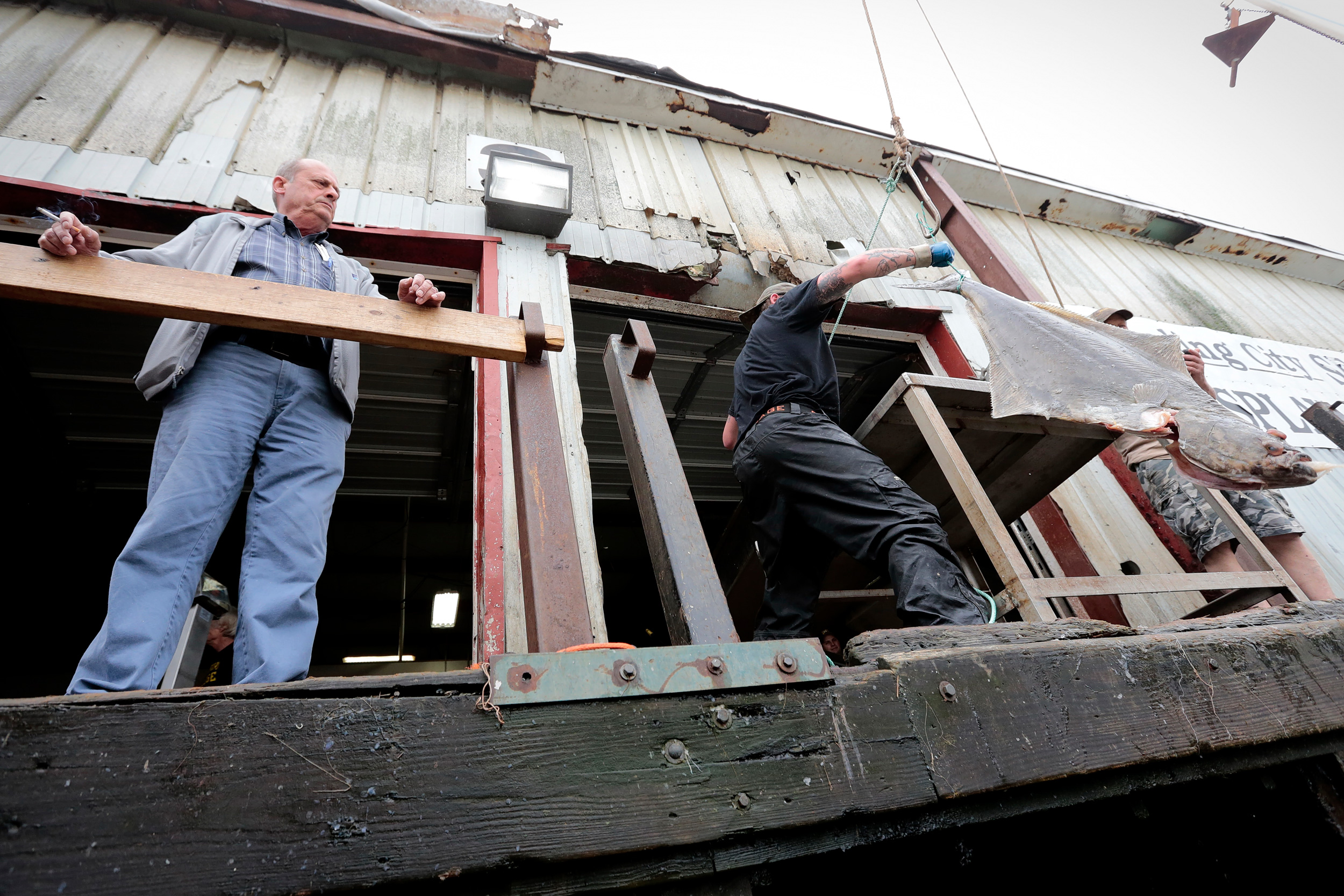
With his trademark Winston cigarette in hand, Carlos Rafael looks on as a crew member unloads halibut from the Titan. For more than 30 years, Rafael has been misrepresenting his catch and circumnavigating the quota system. Photo by Peter Pereira/the Standard-Times
Pissing people off was the collateral damage of Rafael’s greed. He began treating the docks as his personal shipyard, leaving derelict vessels hanging around for years. When harbor personnel tried to get him to move a boat to make room for another fisherman, Rafael threatened their lives, according to two sources who declined to be named for fear of retaliation. “I’ll grab you by the neck and throw you down these stairs,” he told one fisherman, according to a source. “I’ll throw you in the water and when you try to climb up, I’ll hold your head down,” he allegedly told another. Rafael never followed through on any of these threats, but they nonetheless left their recipients shaken.
In 2002, when the US Environmental Protection Agency (EPA) began an effort to remove nine sunken ships from the harbor floor as part of a Superfund cleanup, Rafael had a leaky fishing vessel—Just a Girl—tied up in the Herman Melville Shipyard with a pump running every couple of days to keep it afloat. Rather than move his boat so that the EPA could complete its work, he allowed it to sink and let the government deal with the added cleanup. When the EPA sent him the bill, he sued and lost.
A few years later, a 38-year-old dockworker named Jose Baptista died of carbon-monoxide fumes while working below deck on Rafael’s boat the Sandra-Lee. Rafael told the Standard-Times that he felt awful about it. “It’s beyond our control,” he said. When the US Occupational Safety and Health Administration investigated, he refused to answer their questions on the advice of his lawyer. The agency later fined him $46,000 for negligence.
It’s hard to say exactly when the man who started his career as a fish cutter became The Codfather. Was it in 1995, when he beat federal charges of price-fixing? Was it in 1995, when he bought three scallop boats when the fishery had collapsed and made a killing when it opened up again the next year? Or was it in 1999, when he was arrested for lying to authorities about his fishing history in order to get special permits for squid and black sea bass?
“I am a pirate,” Rafael told regulators during a federal fisheries management meeting, “It’s your job to catch me.” Over two decades, he racked up more than half a million dollars in fines for more than 30 federal fishing violations. His boats have been cited for overfishing, failing to throw back undersized fish and lobsters bearing eggs, having boats with secret coolers in them, blocking coast guard inspectors from boarding, failing to declare fishing trips, and filing false reports on his catch. For Rafael, it was just the cost of doing business.
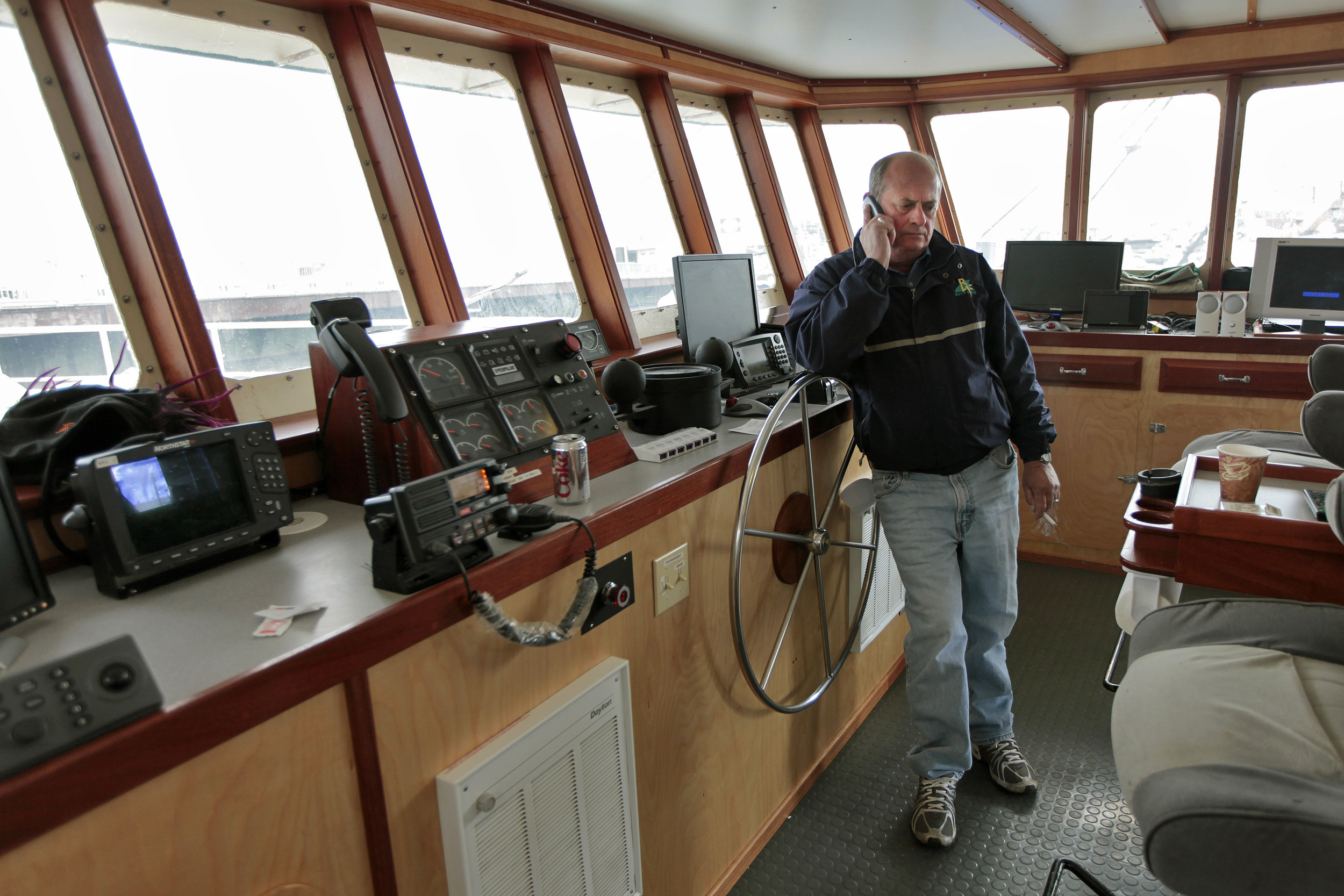
Carlos Rafael makes a business call from the bridge of the Athena, one of his 36 fishing vessels that together control one-fifth of New England’s cod quota. Photo by Peter Pereira/the Standard-Times
A couple of years ago, when the US Coast Guard boarded Rafael’s boat the Bulldog in the Gulf of Maine, the trawl winch began unspooling, sending the net plunging into the ocean and out of sight. The feds suspected the winch brake had been released on purpose. They later retrieved the net and discovered it had an illegal liner designed to prevent undersized fish from slipping through the regulation mesh. The case is under investigation and the captain declined to comment for this article on the advice of his lawyer.
Alan Sherman, who has captained another Rafael boat, Resolute, for six years, says Rafael doesn’t meddle with his fishing and he doesn’t meddle with Rafael’s shoreside business. When Sherman doesn’t like something Rafael has to say, he’s willing to push back. “That’s the trouble with some of these guys that have worked for him,” he says. “They’re afraid of him.” And just as fishermen are afraid of Rafael, they’re also afraid for their future.
The Untouchable Fish
One morning last summer, I stop by Bergie’s Seafood, a small fish house on the waterfront frequented by fishermen who don’t want to sell at an auction dominated by Rafael. After passing through a vinyl curtain into the cool warehouse, I tiptoe around puddles of water on the concrete floor to the carpeted side office and find David Stanley, the vice president of vessel operations, sitting at a computer. “What Carlos did affects the whole industry,” he says bitterly. “Gives us all a big, fat black eye.” If he’s angry at Rafael, he’s even angrier at the federal government for letting the fishing business collapse. “We got fucked,” he says.
In 2010, New England fisheries shifted to a catch shares management system—a kind of cap and trade for fish, where a fisherman or group of fishermen is secured a share of the annual catch. These shares are based on each fisherman’s catch history. The system was supposed to help fishermen avoid a frenzy of competition at the start of each season. They’d be able to fish smarter and reduce the amount of by-catch thrown overboard. But the system has been hamstrung by the uneven recovery of fish stocks.
In 2016, the New England fleet was allowed to catch more than 50,000 tonnes of haddock, but they could only bring up about 1,000 tonnes of cod in the process. They also had to avoid two overfished species of flatfish—American plaice and witch flounder. If an individual fisherman brought up more than his or her share of these species, he or she could buy pricey allocations from other fishermen. But once the fishery-wide quota for any single stock was met, the entire groundfishery came to a halt. In 2015, US fishermen left 76 percent of their haddock quota—worth more than $100-million wholesale—in the ocean.

Total US landings from Georges Bank of Atlantic cod, yellowtail flounder, and haddock from 1960 to 2007. Illustration by Mark Garrison
Catch shares, however, were working swimmingly for Rafael, who said he had accumulated 60 permits and stacked them onto 15 active vessels. He was a pathological whiner, however. He told the press he was tired of paying taxes and angry that Massachusetts had singled him out in restricting a federal aid fund for the troubled fishing industry. In early 2015, he announced that he planned to sell off all his boats and move to Cape Verde, a former Portuguese colony off the coast of Africa. “I’m gonna cash in and screw,” he said. Some thought he was just puffing himself up. But he was serious.
Soon after, a pair of Russian immigrants with sketchy backgrounds reached out to him through a broker and paid a visit to his office that June. Rafael told them he wanted $175-million for the business, but, according to his financial statements, its assets only amounted to $21-million and it was just bringing in between $3- and $4-million in revenue each year.
What gives? the Russians asked.
Rafael pulled a ledger from his desk with the word “cash” on the front. “We are profitable,” he told them. “You will not see it on paper for Carlos Seafood.”
While he was claiming a loss of almost half a million that year, he showed them he brought in an extra $600,000 in cash in just six months. Every day he had a boat come into port, he was sending his fish to Michael Perretti, a convicted felon who ran South Street Seafoods in New York, and Perretti was sending him “jingles”—cash—that he was flying back to Portugal.
At that moment, Rafael seemed to realize what he was admitting to the two strangers. “You could be the IRS in here. This could be a clusterfuck. So I’m trusting you. The only thing is, I open myself because both of you is Russians and I don’t think they would have two Russians. Fuck me—that would be some bad luck!”
In fact, the two Russians and the supposed broker were undercover federal agents, and they were recording the entire conversation for a joint investigation by the IRS and the US National Oceanic and Atmospheric Administration. Over the next year, they would meet with Rafael again and again at his office or a restaurant to learn about the inner workings of his business.
During one meeting in January 2016, he told them about the Hera II, which had recently come back from a trip. Rafael’s employees had unloaded 2,084 kilograms of plaice, which fishermen call dabs, from the hull. Rafael’s entire fleet had the right to catch about 100,000 kilograms of dabs that year, and if he went over his quota he’d have to buy more for $2.20 per kilogram. By reporting as many as possible as haddock, a plentiful fish, he could avoid going over his quota and avoid paying a cent.
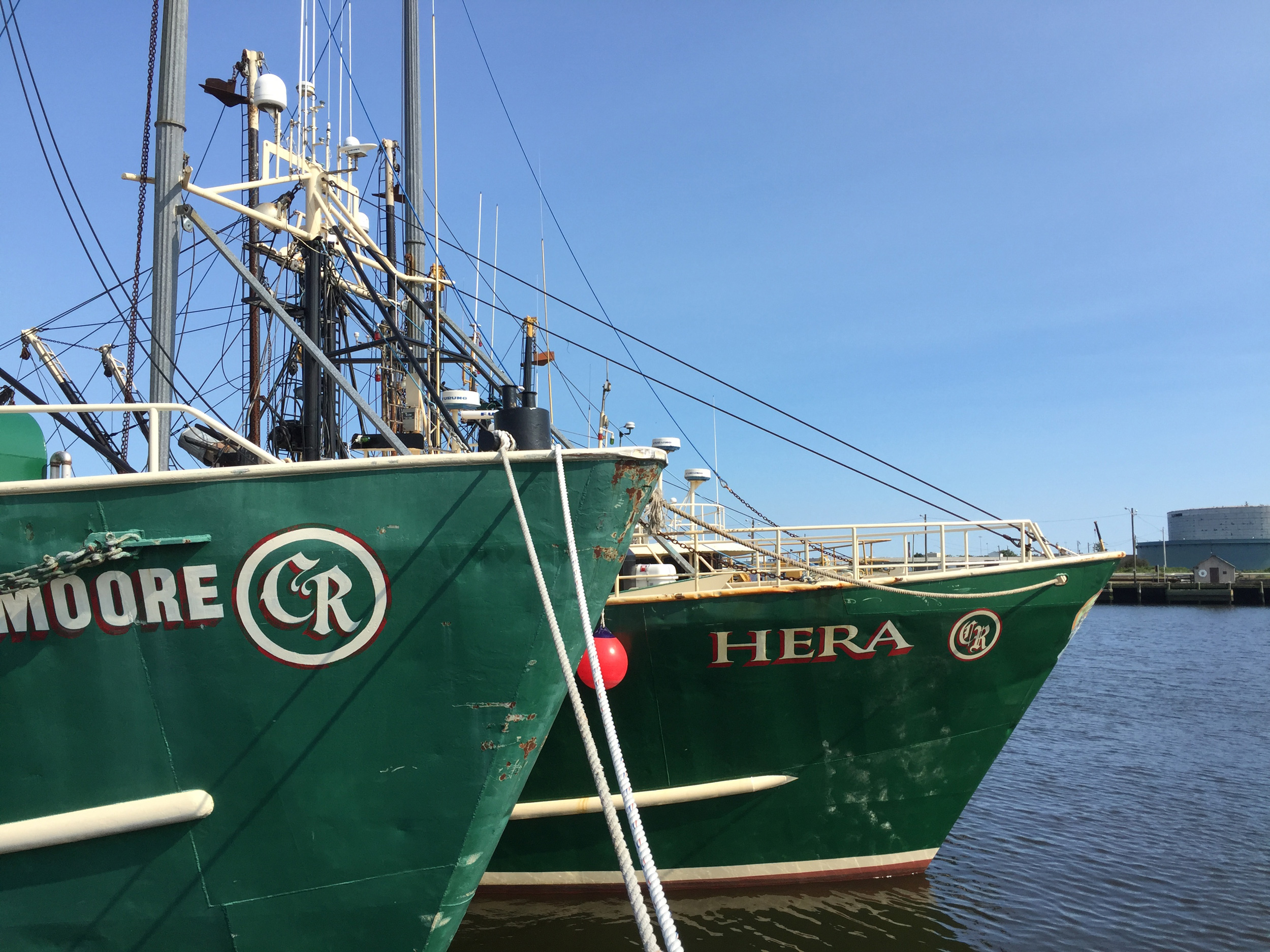
Two of Carlos Rafael’s boats bob in the harbor. One is named Hera after the Greek goddess known for her vengefulness—not unlike Rafael. The Codfather liked the name so much, he used it for two boats. Photo by Brendan Borrell
“We call them something else. It’s simple. We’ve been doing it for over 30 years,” he said. He waits until the dockside inspectors aren’t around and then he starts changing the names. “This year, I’ll have 15 million pounds [6.8 million kilograms] of haddock,” he said, referring to his quota. “So I can call any son of a bitch haddock if the bastards are not there. I rename them. Even when they’re there, I disappear them. I could never catch 15 million. It’s impossible.” Rafael simply shipped his misreported catch bound for Perretti, and then put the rest up for bidding.
He had the same deal going with the Bulldog and 11 other boats, which brought in over 142,800 kilograms of dabs in 2015, while he only reported 69,900. The captains were also allegedly in on his scheme: “The captains know,” he told the investigators. The captain of the Hera II could not be reached for comment, and the captain of the Bulldog declined to comment. All told, Rafael may have lied about 370 tonnes of dabs and summer flounder over the past four years.
Carlos’s Way
On February 26, 2016, federal agents arrested Rafael and hauled away boxes of his records from his office—a two-story sheet metal building painted the color of money, the same shade of green as his boats. If he loses his case, he could spend years in prison and potentially forfeit the 13 boats that have been implicated in the crimes.
News of the arrest quickly rippled across the waterfront. Some worried about the economic fallout and the consequences for their jobs. Others wondered what Rafael had been doing with all his earnings. Rafael wasn’t a flashy man—although he had told investigators he had spent $100,000 on a pleasure boat in the Azores.
An editorial in New Bedford’s Standard-Times called Rafael a persona non grata on the docks. “The fishery will be stronger, more stable, and more sustainable without Mr. Rafael’s corrupting influence,” wrote the newspaper’s editorial board. Still others saw Rafael’s arrest as an indictment of catch shares, which had allowed him to become such a juggernaut. Fishermen have been pushing for an ownership cap on the groundfish fleet, but it has yet to happen.
Federal scientists have also been wondering what Rafael’s alleged crimes mean for the accuracy of their fisheries stock forecasts, considering Rafael was such a dominant player. Predictions about yellowtail flounder stocks, for instance, have been out of whack for a while, and, last year, cod stocks were so bad that scientists had to abandon the model they were using. American plaice and witch flounder are also not following predictions of their models, making it difficult to set quotas.
Mark Terceiro, a fisheries scientist at the National Marine Fisheries Service, says he and his colleagues now have few theories about what’s going on. It could be that their scientific trawl surveys are not performing as well as they used to, or that more fish are dying naturally in the ocean than they realized. But it’s also entirely possible that Rafael’s lies were so massive that they rendered their data useless.
Even if Rafael’s empire crumbles, it’s hard to see how any law-abiding fishermen can profit under current regulations. Most can’t. The value of the groundfish sector in New Bedford declined from $31-million in 2011 to $19-million in 2013, resulting in the loss of over 100 jobs. So far, the monetary losses have been offset by gains in New Bedford’s scallop fishery, which supports fewer jobs and feeds fewer mouths. By weight, New Bedford only receives a quarter of the seafood catch of fishing ports in Alaska or the Gulf Coast. But scallops are selling for as high as $40 per kilogram wholesale, which contributes heavily to the approximately $300-million that New Bedford’s fishing port brings in each year.
Steve Cadrin, a fisheries scientist at the University of Massachusetts in Dartmouth, says fishermen are bringing in so little cod and yellowtail flounder that it’s foolish to think fishing is harming the stocks. Cod, it seems, are not rebounding due to higher water temperatures, a consequence of climate change. “I don’t think we should be constraining our fishery as much as we are,” he says. It’s not a sentiment environmentalists like to hear, but there’s data to support a less restrictive approach to fishing out on Georges Bank.
Jimmy Odlin, a 62-year-old fisherman who owns five trawlers—three homeported in Portland, Maine, and two in New Bedford—estimates that eight out of 10 legal-sized haddock slip through the 15-centimeter mesh he’s required to use. “If you are inefficient at targeting healthy stocks, your only choice is to target unhealthy stocks,” he says.
In 2014 and 2015, he had federal research permits to test out a 13-centimeter mesh inside closed fishing areas on Georges Bank. He caught over 300,000 kilograms of haddock and just 3,600 kilograms of cod and 400 kilograms of dabs. Fisheries observers were looking over his shoulder the whole time and only five percent of the haddock had to be discarded because they were too small.
Odlin owes a large part of his success to using a separator net, which allows cod to escape by swimming downward. (Haddock tend to swim upward.) Haddock are far smaller than cod—typically about a kilogram—which makes them more labor-intensive to process. Odlin invested in efficiency with on-board fish processing machines, so the crew can gut the haddock as quickly as they’re caught.
Odlin’s fish is now billed as “Cape Ann Fresh Haddock” on the menu of the Ninety Nine Restaurant & Pub chain, which has 100 locations in the Northeast. Regulators are considering whether to allow other fishing boats to use this smaller mesh and to change restrictions on the closed fishing grounds Odlin visited. “If we had the proper mesh, people can become more efficient and put less pressure on the other stocks,” he says. Like Rafael, he’s an opportunist who has made the catch shares system work for him, but he also seems to be one of the good guys.
On the Waterfront
Even after Rafael’s arrest, it’s hard to find people in New Bedford who are willing to talk openly about him. One exception is Armando Estudante, the retired fisherman, who agrees to meet me one afternoon at the Dunkin’ Donuts a few blocks from Carlos Seafood. Estudante is an introspective man with a bushy mustache and the shoulders of an aging linebacker. Like Rafael, Estudante migrated to America with next to nothing, and he built himself a comfortable life. He enjoyed Rafael’s sense of humor and admired his work ethic. They even took a trip to the Azores as part of a potential business venture, and Estudante—like Rafael—was arrested for falsifying permit paperwork in 1999. A sinner though he was, Estudante also harbors an old-fashioned sense of ethics and has come to believe that fisheries should be open to all, but with a single rule: one man, one boat. “Why do you need a fleet?” he asks.
Estudante only wanted to provide for his family, Rafael to expand. Over time, a rift between the two men began to develop, and Estudante remembers the moment he began to despise Rafael. On a Saturday afternoon a few years ago, Estudante was coming back from his boat and noticed a dozen laborers waiting at the docks to get paid. Rafael finally drove up with an envelope full of cash and the men dispersed. He and Estudante spoke through their truck windows. “I fucked $250 from out of these guys,” Rafael cackled.
“What?” Estudante said.
“I skimmed $10, $15 from each of them,” he said. Rafael knew that men weren’t going to count their cash on the spot after he kept them waiting for hours. “They were desperate to go home.” Estudante was flabbergasted. He argued with Rafael about it for a few minutes, but Rafael just laughed.
When Estudante thinks about Rafael now, he can still hear that hoarse, cruel laughter in his head, like a net dragging along the rocky seafloor. “He doesn’t give a shit,” Estudante says.
On my last day out on the docks, I find myself admiring the gritty beauty of the working harbor. The old boats are lashed together, bobbing up and down in the oily water, as young immigrants sweat in the summer sun, repainting rusting hulls—a ritual that has happened here for hundreds of years. But the boats I’m looking at are all Rafael’s. Somewhere along the way, these docks have become unmoored from their noble history as a piece of the American dream. They now stand as a rotting monument to one man’s avarice.

